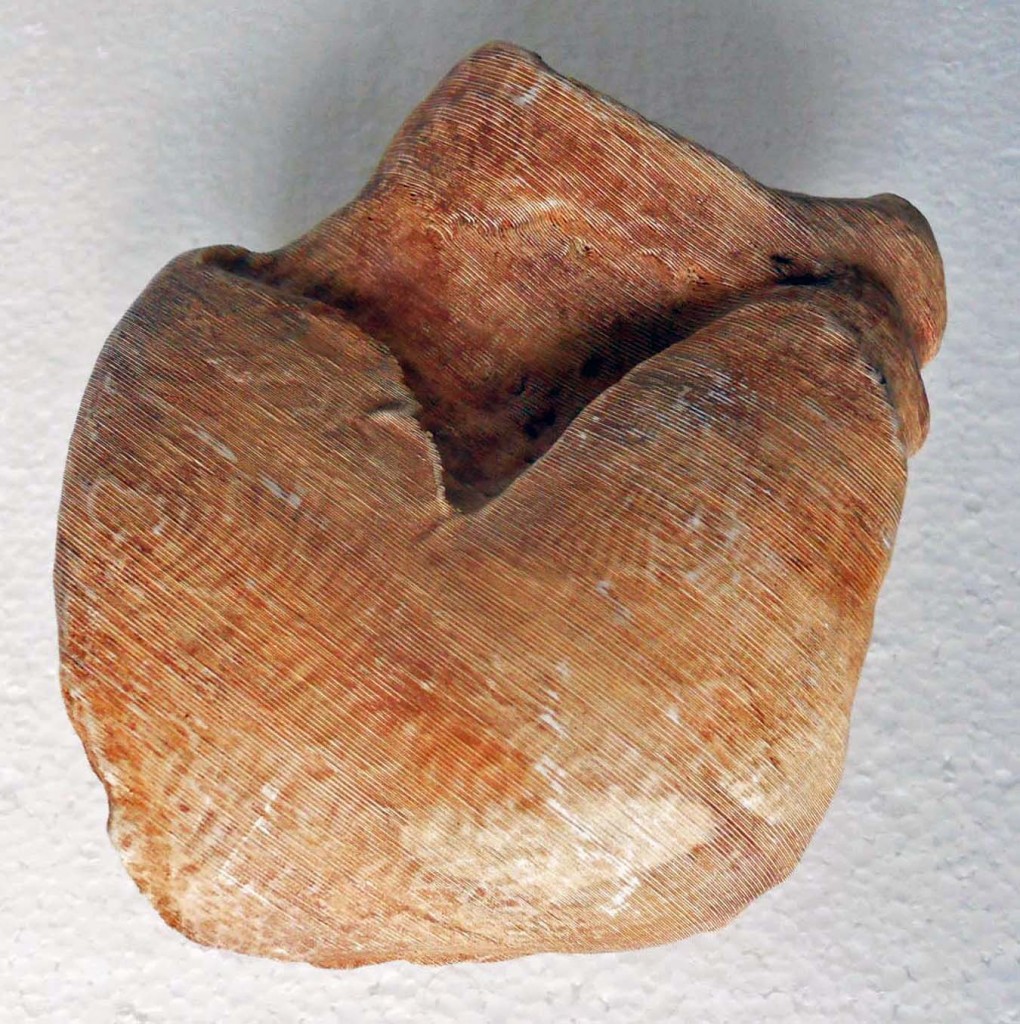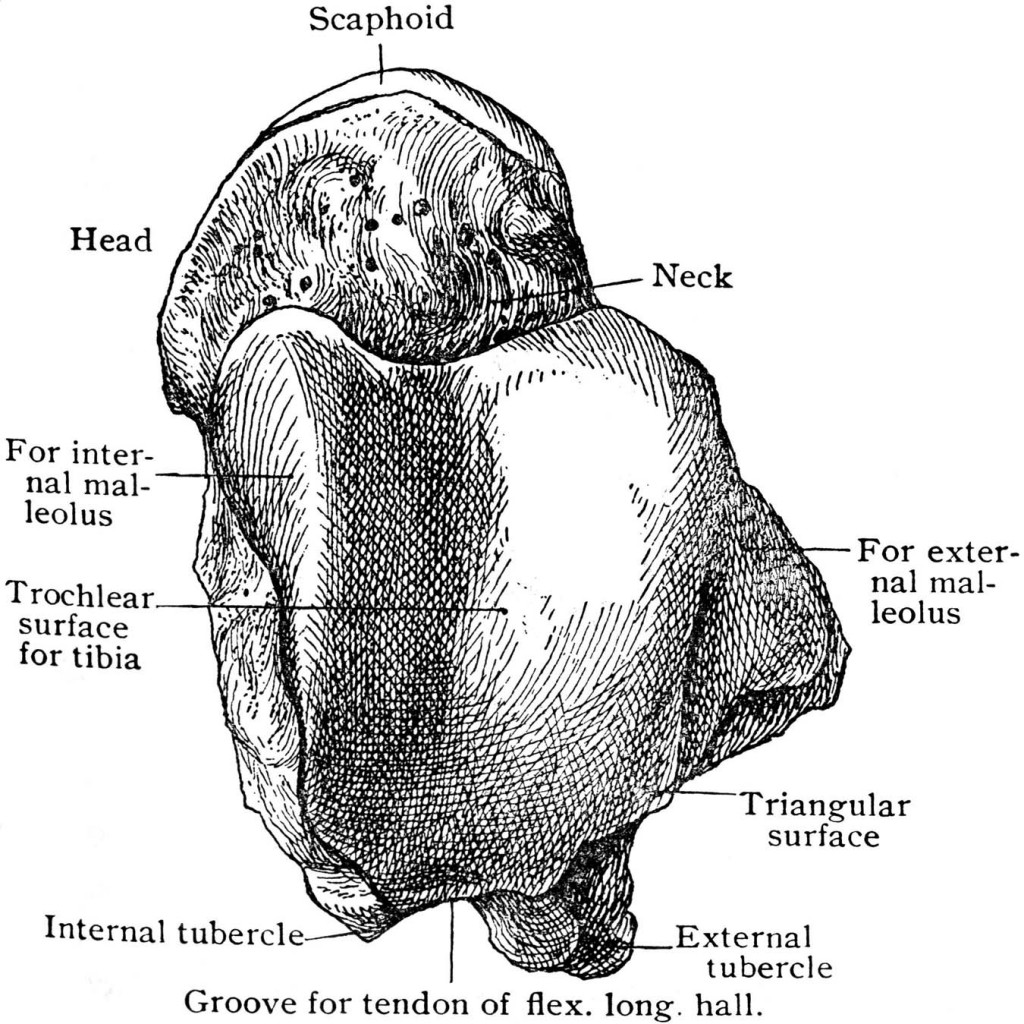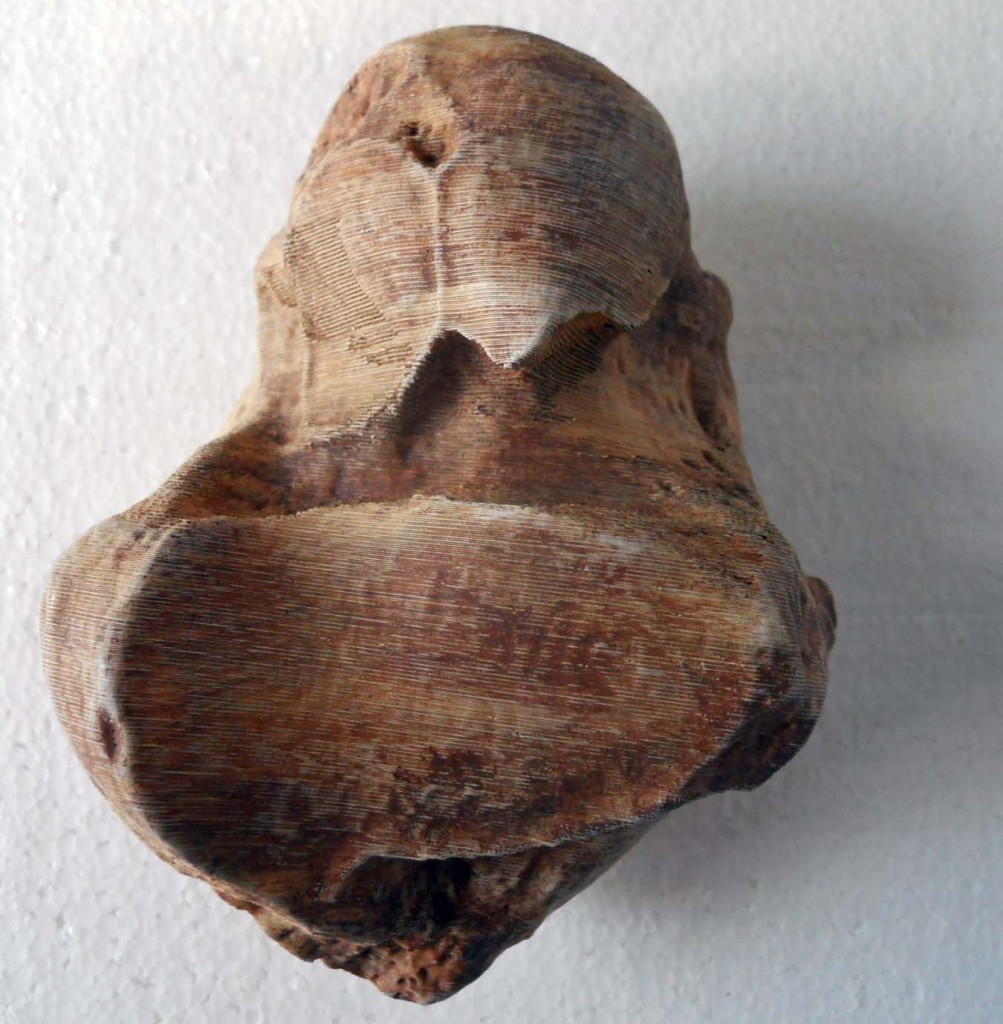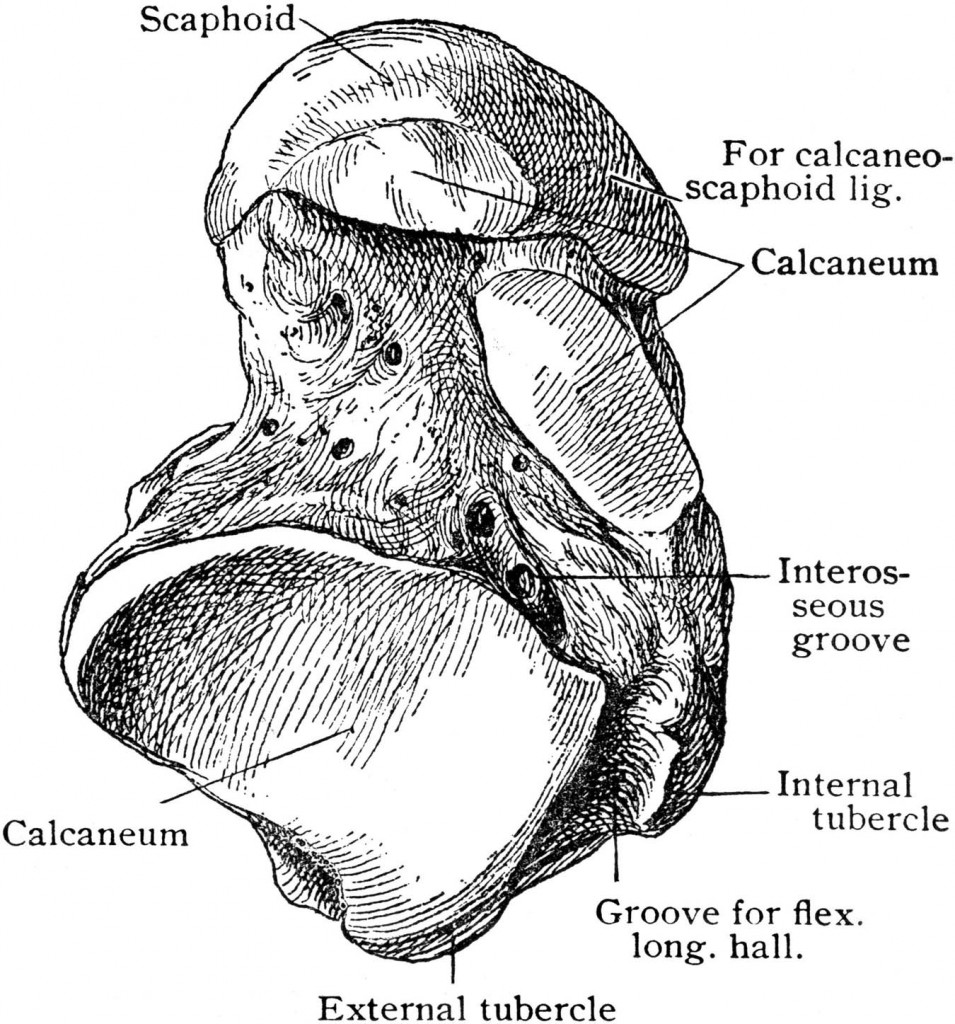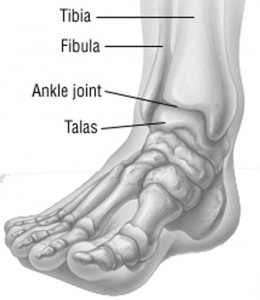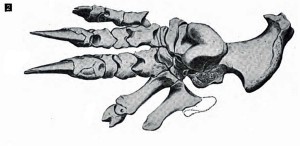Introduction to Walk Like a Sloth: lessons in ground sloth locomotion
 Getting Oriented
Getting Oriented
The astragalus (called the talus in humans) is basically the fulcrum of a lever rocking on the calcaneum or heel bone like a teeter-totter, moving the foot up and down when muscles pull on the Achilles tendon.  The astragalus has a convex side (the superior or “up” side) and concave (inferior or “down”) side. With the convex side up you’ll see a heart-shaped articulating surface—orient the bone so it looks like a Valentine’s Day heart. The smooth surface on the left side of the heart wraps around the bone and makes a right angle down to the bottom. The fibula articulates on the left (lateral) side of the heart, extending down the outside of the astragalus, providing stability with its projecting tip. The tibia sits on the right (medial) side of the astragalus providing the main support for the leg column. A pear-shaped cupped depression projects forward and slightly to the right pointing to the sloth’s big toe—that articulates with the navicular bone, which serves as the base for toes 1-3. Extending laterally (to the left) from the navicular cup is the articulation for the cuboid bone, which connects to toes 4-5. Turn the bone over. The astragalus rocks on the calcaneum in a concave saddle formed by two articulating surfaces– a large one posterior and a smaller one anteriorly and medially (on the left side now). Note that the joint runs diagonally across the bottom– the astragalus rides “sidesaddle” on the calcaneum.
The astragalus has a convex side (the superior or “up” side) and concave (inferior or “down”) side. With the convex side up you’ll see a heart-shaped articulating surface—orient the bone so it looks like a Valentine’s Day heart. The smooth surface on the left side of the heart wraps around the bone and makes a right angle down to the bottom. The fibula articulates on the left (lateral) side of the heart, extending down the outside of the astragalus, providing stability with its projecting tip. The tibia sits on the right (medial) side of the astragalus providing the main support for the leg column. A pear-shaped cupped depression projects forward and slightly to the right pointing to the sloth’s big toe—that articulates with the navicular bone, which serves as the base for toes 1-3. Extending laterally (to the left) from the navicular cup is the articulation for the cuboid bone, which connects to toes 4-5. Turn the bone over. The astragalus rocks on the calcaneum in a concave saddle formed by two articulating surfaces– a large one posterior and a smaller one anteriorly and medially (on the left side now). Note that the joint runs diagonally across the bottom– the astragalus rides “sidesaddle” on the calcaneum. 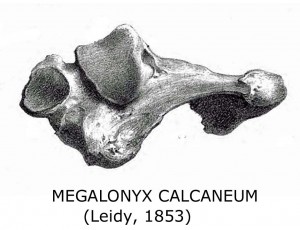 The deep groove separating the front and back joints is called the interosseus groove or sulcus tali. It lines up with a corresponding groove on the calcaneum forming a deep bony canal called the sinus tarsi. The rough texture of the canal serves to anchor a strong inch-wide ligament called the interosseous talocalcaneal ligament (ITCL) which ties these two critical foot bones together.
The deep groove separating the front and back joints is called the interosseus groove or sulcus tali. It lines up with a corresponding groove on the calcaneum forming a deep bony canal called the sinus tarsi. The rough texture of the canal serves to anchor a strong inch-wide ligament called the interosseous talocalcaneal ligament (ITCL) which ties these two critical foot bones together.
 Key points
Key points
#1 Before you identify the bone for students ask them to look for clues about where it goes, especially noting the articulating surfaces. Where could it fit in your (or the sloth’s) body? There are smooth surfaces connecting to other bones on every side, in fact, they cover about 70% of the bone. In life they would be coated with cartilage. These are clues to a bone with great flexibility, i.e. a junction with many bones attached and moving in different directions. Where do you need flexibility like that in your body? [Answer: ankles and wrists. Fingers (and paws) would be pretty useless if they couldn’t be turned in every direction. Although less flexible, ankles provide movement for safe and stable foot placement, especially important on uneven ground.]
#2 Finding the astragalus made identification of the sloth easy. At the junction of the lower leg, foot, and heel, the bone reveals a lot about how the animal walked. The shape and other characteristics indicate Megalonyx walked flat-footed, or plantigrade rather than on the sides of its feet like other ground sloths (that’s called pedolateral walking–more about it below).
 Additional information
Additional information
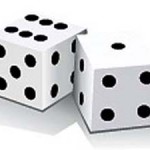
In Greek “astragalus” means a die (as in dice) because their six-sided shape made them natural for carving into dice for gambling and games. (Aiello and Dean, 1990).
The feet show other evidence of Megalonyx’s plantigrade (i.e. flat-footed) stance– the foot is symmetrical around the middle toe. That distributes the weight evenly–there’s no reduction of the 1st and 4th toes or expansion, flattening or thickening of the 5th metatarsal (foot bone) and calcaneum to support weight as in other ground sloths. Humans walk plantigrade too, but our toes taper from the big toe to the little one.
 In most large (game-sized) mammals the fibula is either fused to the tibia or totally absent. Only ground sloths, carnivores and primates have a complete and separate fibula bone in their lower legs. Note that the heart-shape of the superior surface of the astragalus is wider toward the front and the lateral articulating surface with the fibula is undercut. If the fibula was fused to the tibia the lower leg could not slide over the ankle. We could either walk with a limp or break the lateral malleolus of the fibula after just a couple of steps. Instead, we have springy muscles and ligaments connecting the tibia and fibula and holding the astragalus
In most large (game-sized) mammals the fibula is either fused to the tibia or totally absent. Only ground sloths, carnivores and primates have a complete and separate fibula bone in their lower legs. Note that the heart-shape of the superior surface of the astragalus is wider toward the front and the lateral articulating surface with the fibula is undercut. If the fibula was fused to the tibia the lower leg could not slide over the ankle. We could either walk with a limp or break the lateral malleolus of the fibula after just a couple of steps. Instead, we have springy muscles and ligaments connecting the tibia and fibula and holding the astragalus  in a tight but flexible grip from the top and side like a mortise and tenon joint. (Weinert et al., 1973) Scientists believe this joint evolved in response to the complexity of locomotion in the aforementioned families of mammals–i.e. chasing agile prey, tree climbing and bipedalism. (Aiello and Dean, 1990)
in a tight but flexible grip from the top and side like a mortise and tenon joint. (Weinert et al., 1973) Scientists believe this joint evolved in response to the complexity of locomotion in the aforementioned families of mammals–i.e. chasing agile prey, tree climbing and bipedalism. (Aiello and Dean, 1990)
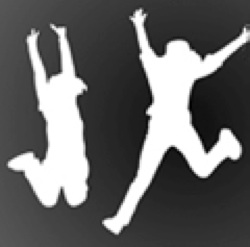 Things to do
Things to do
Feel your ankle bones. Those bumps we commonly call our “ankle bones” aren’t the astragalus (talus) at all. They are the malleoli (plural of maleolus) on your lower leg bones wrapping around the astragalus. Maleolus is Latin for “little hammer” (think “mallet”). Feel the medial maleolus of the tibia on the inside and the lateral maleolus of your fibula on the outside. . . now you know what sloth “ankles” feel like!
Swivel like other sloths Walking on the sides of their feet with the soles and claws turned inward may have brought some advantages for the pedolateral sloths. Claws stayed sharper when not abraded by walking–the equivalent of cats retracting their claws. The stance also gave those sloths the ability to swivel their bodies and face predators more quickly than by shuffling their feet to turn around. For heavy animals with a slow metabolism and bones that couldn’t endure athletic bending, twisting or off-balance movements, the pedolateral swivel might have been the ideal solution.
It is impossible to demonstrate the “ground sloth swivel” with human feet but you can mimic the movement by using your hands and wrists to represent feet. Stand up and rest your hands on your desk palms up; turn them slightly in and forward to keep your nails off the ground and sharp! Now you are standing like a pedolateral sloth. Pretend a giant ice age dire wolf suddenly jumps up behind you—turn your shoulders and face the danger by swiveling on your wrists–that’s how the pedolateral sloths turned rapidly on their ankles. Now pretend you are a flat-footed sloth like Megalonyx and the same thing happens. Stand up and rest your hands palms down on your desk. Can you twist your body nearly as far? How fast can you shuffle your “feet” to turn around? Which position, the pedolateral swivel or the flat-footed shuffle, allows you to turn your body more and puts you in a position to defend yourself faster? Now we may have a clue about how our adult got the wound on its tail! (see the caudal vertebrae lesson)
Flex Your Muscles The astragalus is the only bone in the body that doesn’t have any muscles or tendons attached to it. (Aiello and Dean, 1990) There isn’t a lot of room in your feet for muscles so all the major ones originate on the long bones of the leg, that is the femur, tibia or fibula. These so-called “long muscles” narrow to slender tendons near the ankle and cross over, under and around it to reach their insertion points on the metatarsals and phallanges. The so-called “short muscles” that originate on the foot are only used for fine-tuning when you stand and walk, distributing pressure and adjusting to uneven ground.
Point your toes like a (plantigrade) sloth Note again the high rounded heart-shaped dome of the top of the astragalus that supports the tibia and fibula. It covers the entire top surface, curving from the articulation with the navicular at the anterior (front) end to the posterior (back) articulation with the calcaneum. This gave Megalonyx a wide range of extension and flexion of the feet. Sit on a chair and lift your leg.  Extend (point) your toes; now flex them (pull your toes back). That’s your astragalus rolling on the bottom of your tibia and fibula. Now you are bending your feet like Megalonyx. This motion was impossible for sloths with pedolateral feet . . . heart-breaking for any who dreamed of a career in ballet.
Extend (point) your toes; now flex them (pull your toes back). That’s your astragalus rolling on the bottom of your tibia and fibula. Now you are bending your feet like Megalonyx. This motion was impossible for sloths with pedolateral feet . . . heart-breaking for any who dreamed of a career in ballet.
Ski like a sloth The astragalus’s side-saddle articulation with the calcaneum, called the subtalar joint, lets you turn the sole of your foot inward (inversion), like when you sprain your ankle, or out (eversion). That’s important when walking on uneven ground and skiing. Crouch down like skier going downhill; now pretend you are going into a turn–as you shift your hips you’ll bend your ankles in the opposite direction. That’s to keep your center of gravity over your feet. Thank your subtalar joint for that.
 Now bend and turn in the opposite direction. . . and continue the rest of the way downhill. Now you are skiing like a sloth! Most of us can invert our ankles about 30 degrees but the subtalar joint only allows about 15 degrees of eversion.
Now bend and turn in the opposite direction. . . and continue the rest of the way downhill. Now you are skiing like a sloth! Most of us can invert our ankles about 30 degrees but the subtalar joint only allows about 15 degrees of eversion.
Math Fun Forensic scientists occasionally use the astragalus to estimate stature when the long (leg) bones are unavailable. They are hard compact bones, fuse early, and may survive a disaster better than others. Here’s a formula Pablos et al. (2013) developed for the astragalus from a mixed sample of American adults born between 1825-1910. Just for fun try it on our adult sloth. 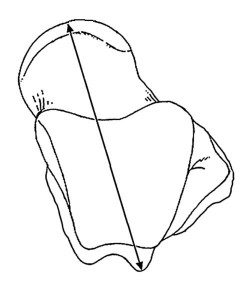 Measure the maximum length of the bone (in millimeters) from its most anterior point to the most posterior point, as shown. Compare your answer to the stature estimates you calculated in the radius lesson and ulna lesson.
Measure the maximum length of the bone (in millimeters) from its most anterior point to the most posterior point, as shown. Compare your answer to the stature estimates you calculated in the radius lesson and ulna lesson.
Stature (in millimeters) = 12.22 X length (in mm.) + 988.6 ± 106.4
[The astragalus is 143 mm. long, which works out to 2736 mm., or 107.7 inches; in other words, 9 ft.- 0 in. ± 4 inches. Surprisingly close to our previous calculations!]
 Things to think about
Things to think about
Why is Megalonyx one of the few ground sloths not to walk on the sides of its feet? Flat feet are generally seen by sloth scientists as a primitive characteristic but Megalonyx lived in a wider variety of habitats than any other ground sloth. Could flat feet be an advantage in certain habitats? [It increases foot area, which means lower foot-loading, i.e. easier travel over terrain where the animal might sink in. Walking flat-footed might have made it easier for Megalonyx to travel across snow and ice. (Harington, 1995)] Could sloths walk faster on flat feet? Dig faster? Perhaps flat feet provided better contact with the ground for detecting vibrations and communicating. (see toe bones lesson)
In some ways the astragalus functions much like the atlas in the neck (see the atlas lesson)–with joints on the opposite ends oriented at approximately 90° to each other, the bones allow a wide range movement when they work together. The upper surface of the astragalus corresponds roughly to the “yes” joint of the atlas with the tibia sliding forward and back; the lower surface corresponds to the “no” joint at the opposite end of the atlas with the astragalus sliding medially and laterally over the calcaneum. Working together it means greater versatility and whatever the slope of the ground, the foot can meet it and push off it flat.
 Future research
Future research
There may be small signs of arthritis in the astragalus, e.g. the lips around the edges of some of the articulating surfaces. If so, it is minor. We don’t see any other bones with this pathology, but we’ll keep looking for clues to the question, “How old is our adult?” With most mammals you can simply look at the teeth for an answer, but sloths had ever-growing, ever-young teeth (see the tooth lesson) . . . .
The evidence for a slow metabolism and hence sluggish movement in ground sloths is based on the extant tree sloths and dated research. (Ho, 1967) The species’ range–further north than any other ground sloth, into northern Canda and Alaska, suggests a metabolism well able to keep up with the demands placed on it.
Conclusion
The astragalus serves as the center-of-action of the foot and no other bone in ground sloths is more useful for identifying a particular species. Megalonyx was unusual in the ability to stand flat-footed but whether they routinely walked bipedally that way is a different question. Fossil trackways show even some pedolateral (i.e. ankle-walking) sloths were bipeds when they wanted to be. We’ll have to look at other bones for a definite answer to the question was Megalonyx bipedal.
TO LEARN MORE ABOUT OR TO BORROW THE UNIVERSITY OF IOWA MUSEUM OF NATURAL HISTORY GEO-2-GO DISCOVERY TRUNKS CALL OR CONTACT THE MUSEUM.
References
Aiello, L. and Dean, C. 1990. Introduction to Human Evolutionary Anatomy. Academic Press Limited. San Diego, CA
Blanco, E. and Rinderknecht, A. 2008. Estimation of hearing capabilities of Pleistocene Ground Sloths (Mammalia, Xenarthra) from middle-ear anatomy. Journal of Vertebrate Paleontology 28: 274-276.
Educational Technology Clearinghouse, Florida Center for Instructional Technology, College of Education, University of Southern Florida http://etc.usf.edu/clipart/
Harington, C. R. 1995. Jefferson’s ground sloth. Beringian Research Notes 1: 1-4.
Hay, O. P. 1914. The Pleistocene Mammals of Iowa. Iowa Geological Survey 23; Des Moines, Iowa.
Ho, Tong-Yun, 1967. Relationship between imino acid contents of mammalian bone collagen and body temperature as a basis for estimation of body temperature of prehistoric animals. Comparative Biochemical Physiology 22: 113-119.
Leidy, J. 1853. A Memoir on the Extinct Sloth Tribe of North America. T. K & P. O. Collins, Printers, Philadelphia.
Madey, S. M., Cole, K. J. and Brand, R.A. 1997. Sensory innervation of the cat knee articular capsule and cruciate ligament visualized using anterogradely transported wheat germ agglutionin—horseradish peroxidase. Journal of Anatomy 190: 289-297.
Pablos, A., Gomez-Olivencia, A., Garcia-Perez, A., Martinez, ., Lorenzo, C. and Arsuaga, J. L. 2013. From toe to head: use of robust regression methods in stature estimation based on foot remains. Forensic Science International 226: 299.e1-299.e7.
Weinert, C. R., Jr., McMaster, J. H. and Ferguson, R. J. 1973. Dynamic function of the human fibula. American Journal of Anatomy 138: 145-150.

